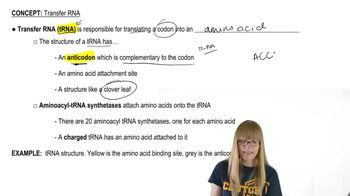A portion of a DNA template strand has the base sequence 5′-...ACGCGATGCGTGATGTATAGAGCT...-3′
Assume the mRNA is written in the correct reading frame. Determine the amino acid sequence encoded by this fragment. Identify the N- and C-terminal directions of the polypeptide.
Ch. 9 - The Molecular Biology of Translation
Chapter 9, Problem 7
Identify the amino acid carried by tRNAs with the following anticodon sequences.
5′-UAG-3′
 Verified step by step guidance
Verified step by step guidance1
Identify the mRNA codon that pairs with the given tRNA anticodon. The anticodon 5'-UAG-3' pairs with the mRNA codon 5'-CUA-3'.
Use the genetic code table to find the amino acid corresponding to the mRNA codon 5'-CUA-3'.
The mRNA codon 5'-CUA-3' codes for a specific amino acid.
Verify the amino acid by cross-referencing with a reliable genetic code chart.
Conclude which amino acid is carried by the tRNA with the anticodon 5'-UAG-3'.

Verified video answer for a similar problem:
This video solution was recommended by our tutors as helpful for the problem above.
Video duration:
2mWas this helpful?
Key Concepts
Here are the essential concepts you must grasp in order to answer the question correctly.
tRNA and Anticodons
Transfer RNA (tRNA) is a type of RNA molecule that helps decode a messenger RNA (mRNA) sequence into a protein. Each tRNA molecule has an anticodon, a sequence of three nucleotides that is complementary to a corresponding codon on the mRNA. The anticodon ensures that the correct amino acid is added during protein synthesis.
Recommended video:
Codon-Amino Acid Relationship
In the genetic code, a codon is a sequence of three nucleotides on mRNA that specifies a particular amino acid. The relationship between codons and amino acids is defined by the genetic code, which is nearly universal among organisms. For example, the codon UAG is a stop codon, which signals the termination of protein synthesis rather than coding for an amino acid.
Recommended video:
Stop Codons
Stop codons are specific sequences in mRNA that signal the end of translation, the process of synthesizing proteins. The three stop codons—UAA, UAG, and UGA—do not correspond to any amino acids and instead instruct the ribosome to release the newly formed polypeptide chain. In this case, the anticodon 5′-UAG-3′ indicates that the tRNA does not carry an amino acid but rather signals the termination of protein synthesis.
Recommended video:
Guided course

Translation Termination
Related Practice
Textbook Question
327
views
Textbook Question
What are the differences between the universal code and that found in the mitochondria of some species? Given that some changes (UGA =stop→Trp) have occurred multiple independent times in evolution, can you think of any selective advantage to the mitochondrial code?
314
views
Textbook Question
Describe three features of tRNA molecules that lead to their correct charging by tRNA synthetase enzymes.
255
views
Textbook Question
Identify the amino acid carried by tRNAs with the following anticodon sequences.
5′-AAA-3′
214
views
Textbook Question
Identify the amino acid carried by tRNAs with the following anticodon sequences.
5′-CUC-3′
247
views
Textbook Question
Identify the amino acid carried by tRNAs with the following anticodon sequences.
5′-AUG-3′
293
views

